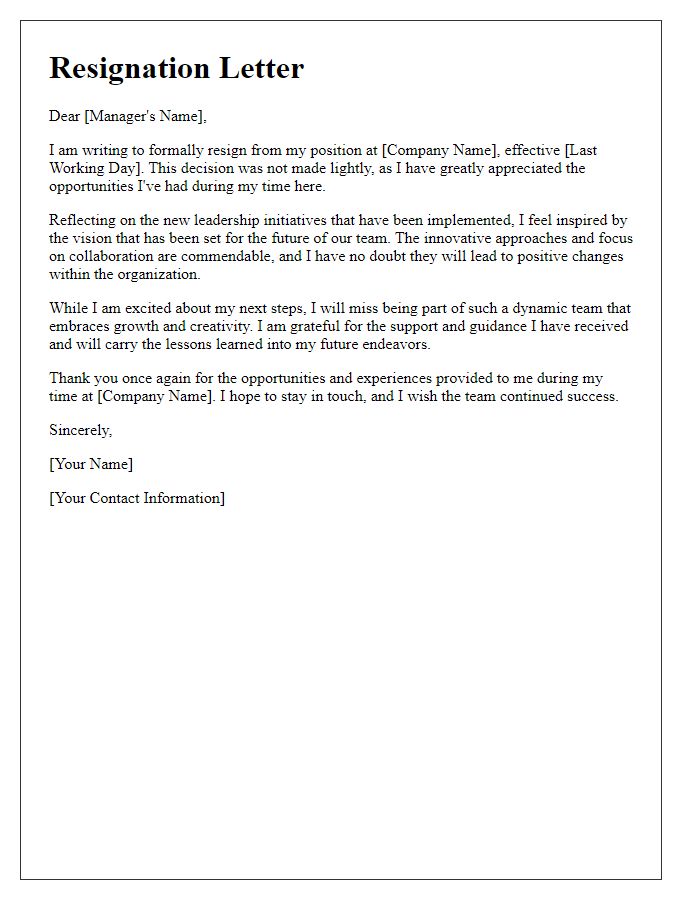In today's fast-paced work environment, navigating a leadership change can be both challenging and rewarding. When deciding to resign, it is essential to communicate your decision thoughtfully, acknowledging the shift in leadership while expressing gratitude for the experiences you've gained. Sharing your reasons for leaving can help maintain positive relationships and leave the door open for future opportunities. If you're contemplating your next steps and want to learn more about crafting the perfect resignation letter, keep reading!

Professional tone
In the wake of a leadership change at the company, the decision to resign has arisen to seek new opportunities. Recent adjustments in management structure, particularly the transition in executive leadership, have prompted a reassessment of personal career goals. After considerable reflection, the desire to pursue different avenues aligned with professional aspirations has emerged. This transition period marks a pivotal shift within the organization, and it seems an opportune moment to explore new challenges in a dynamic environment. Gratitude is extended for the experiences and opportunities provided during the tenure, which have contributed significantly to professional development and personal growth. The aim is to ensure a smooth transition process and to support the team during the adjustment period.
Clear statement of resignation
A leadership change can significantly impact an organization's dynamics. Employee morale often fluctuates during such transitions, leading to uncertainty regarding future direction. A clear statement of resignation conveys a professional approach, ensuring that colleagues and management remain informed about intentions. Articulating reasons for departure, whether personal or professional, contributes to a transparent culture. Including a note of gratitude toward current leadership reinforces positive relationships. Additionally, specifying a final working date aids in creating a smooth transition. Overall, a thoughtful resignation letter during a leadership change reflects awareness of organizational context and individual career aspirations.
Brief mention of new leadership
In a transformative period for the organization, I formally submit my resignation effective immediately. The recent appointment of [New Leader's Name] as [New Leader's Title] has initiated a shift in our strategic direction that necessitates my departure. Embracing new leadership brings a fresh perspective and innovative ideas that will undoubtedly propel [Company Name] forward. As we transition, I remain confident in the abilities of the new leadership team to guide us to success. I am grateful for the opportunities I have had during my tenure and wish the team continued growth and achievement.
Expression of gratitude
As a result of a significant leadership change within the organization, I have decided to submit my resignation from my position at [Company Name], effective [Last Working Day, e.g., two weeks from today]. I want to take this opportunity to express my heartfelt gratitude for the experiences I have gained during my tenure here, specifically highlighting the mentorship I received from [Name of the Leader or Mentor], who has had a profound impact on my professional growth. The supportive environment at [Location or Division, e.g., the marketing department] fostered my development and allowed me to contribute to projects such as [Specific Project or Achievement]. I sincerely appreciate the collaborative spirit and dedication of my colleagues, which made every challenge enjoyable and rewarding. While I look forward to new opportunities, I will always cherish my time at [Company Name], and I am committed to ensuring a smooth transition for my responsibilities.
Contact information for future communication
Transitioning leadership creates significant shifts within organizations. Upcoming leadership changes can influence team dynamics, work culture, and strategic direction. Maintaining open communication is essential during this period to ensure a smooth handover of responsibilities and expectations. Providing contact information for future correspondence facilitates ongoing collaboration and support, fostering positive relationships even after departure. This step not only aids in organizational continuity but also demonstrates professionalism and commitment to the success of the team.
Letter Template For Resignation Highlighting Leadership Change Samples
Letter template of resignation due to organizational leadership transition

Letter template of resignation motivated by changes in executive direction












Comments